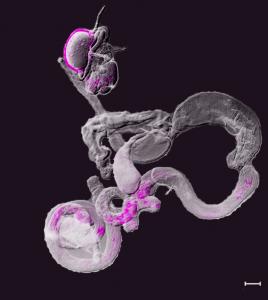Bond gene in fruit flies controls fertility of rival males
University of Hawaiʻi at MānoaAssistant Professor, PBRC, School of Ocean and Earth Science and Technology
Marcie Grabowski, (808) 956-3151
Outreach Coordinator, School of Ocean and Earth Science and Technology
For many animals, pheromones, which are chemical cues used for communication, guide important decisions such as whom to mate and whom to fight. New research from scientists at UH Mānoa’s (UHM) Pacific Biosciences Research Center (PBRC), a newly integrated research unit of the School of Ocean and Earth Science and Technology (SOEST), identified a single gene in fruit flies (Drosophila) that controls male pheromone production, male fertility and, surprisingly, the fertility of rival males.
Insects use a tremendous diversity of pheromone chemical signals to guide their behaviors but little is known about how pheromone diversity evolves.
“Our work reveals that one way new pheromones are produced is by hijacking genes which are used for other biological processes – in this case, male fertility,” said Joanne Yew, assistant professor at PBRC and lead author of the study published today in Nature Communications. “The findings reveal a molecular mechanism by which novel traits evolve, a long-standing problem in evolutionary biology.”
The gene, named "bond," was found using genetic screening, which identified genes in Drosophila that are involved in pheromone synthesis. The researchers used the technique to knock out the function of candidate genes, one by one, within the male reproductive organs. In assessing the pheromone profile of the mutated flies, the scientists noted that the male flies in which bond expression was silenced were missing one of the major sex pheromones.
Bond, as they discovered, is a powerful gene. It encodes an enzyme that is needed to make certain pheromones and components of sperm cell membranes, thus affecting behavior and fertility.
A strain of mutant flies – in which the DNA region encoding bond had been eliminated – was placed with normal females and allowed to mate. The mutant males produced very few offspring compared to normal flies.
To determine the influence of bond on social behaviors, one normal male was placed in the company of either mutant males or normal males. After a few days, males that had been housed with mutant males produced fewer offspring compared to flies housed with normal males.
"Our results show that male flies use pheromones to 'size up' the competition," said Yew. "In the absence of the normal chemical signals that signify potential rivals, males lower their sperm investment. This implies that males need a sense of competition to ensure reproductive success."
These surprising findings show that fertility is a dynamic trait that is affected by social conditions and the perception of sensory signals. More broadly, the results also indicate that the perception of tastes and smells – senses that are used to detect pheromones – can have profound effects on reproductive physiology and could be relevant to reproductive disorders.
In the future, Yew and colleagues will explore how, on a molecular level, pheromone signals alter fertility.
* * *
Citation information
The fatty acid elongase Bond is essential for Drosophila sex pheromone synthesis and male fertility (2015) Nature Communications. doi: 10.1038/ncomms
Full photo caption:
The enzyme Bond (purple) controls male pheromone production and fertility in Drosophila, and is found in various organs of the male reproductive system (gray). Scale bar: 100 µm.
Credit: Wan Chin Ng and Joanne Yew
For more information, visit: http://www.pbrc.hawaii.edu/

